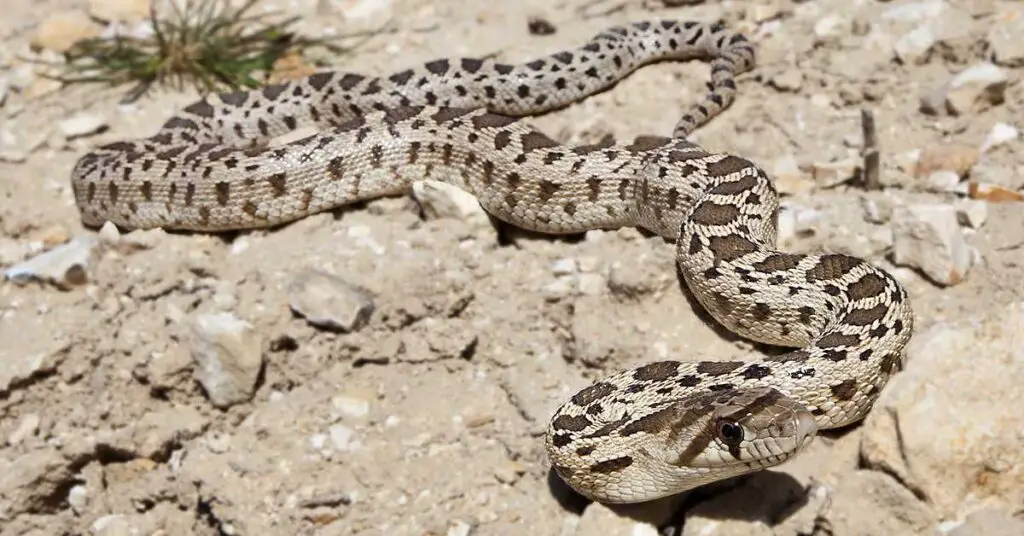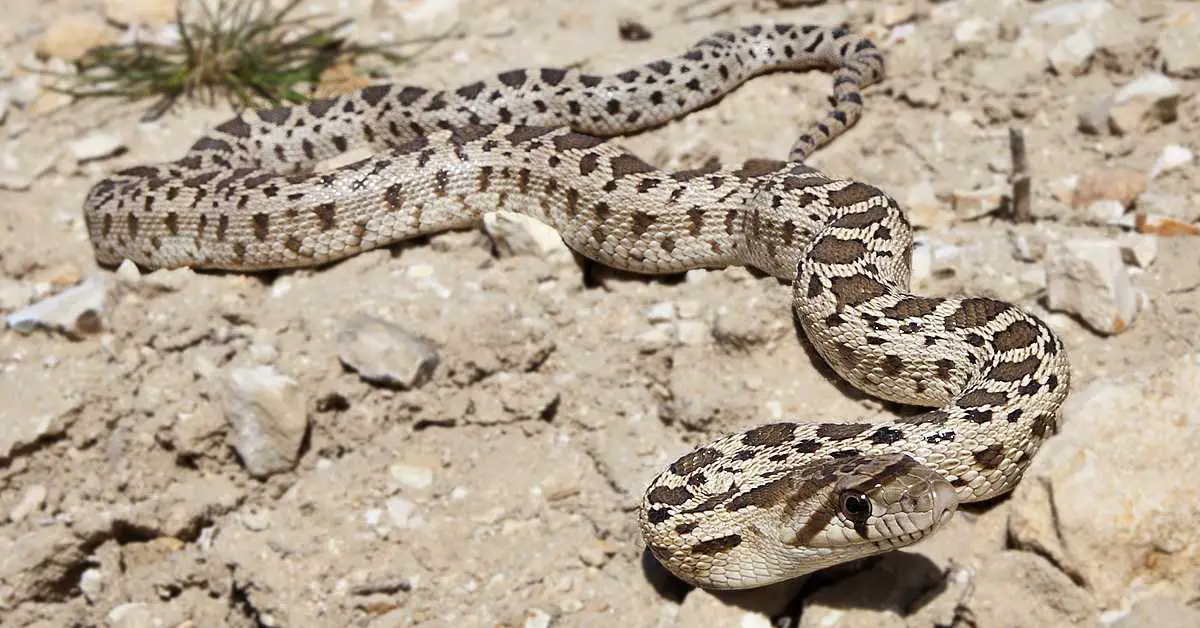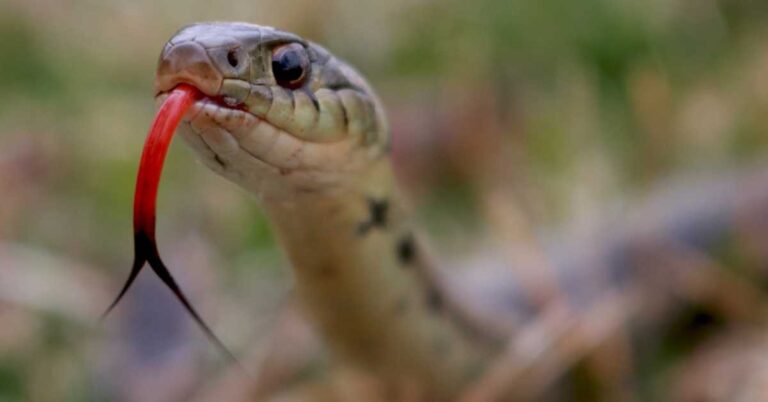Have you ever come across a gopher snake while hiking in the desert? You might have wondered if these snakes are dangerous. Well, let’s find out!
Gopher snakes, known for their impressive size and unique markings, are a common sight in many parts of North America. In this article, we will explore their physical appearance, habitat, diet, and defensive behavior to determine if they pose a threat to humans and pets.
By understanding the true nature of gopher snakes, you can learn how to coexist with these fascinating creatures and appreciate their valuable role in the ecosystem. So, let’s dive in and uncover the facts about gopher snake danger!
Key Takeaways
- Gopher snakes are non-venomous and do not possess venom glands or fangs.
- They rely on their powerful constricting abilities to subdue their prey.
- Gopher snakes can imitate the aggressive behavior of venomous snakes, like rattlesnakes, to deter predators.
- While their bites are harmless and rarely break the skin, it is important to practice snake safety tips and seek medical attention if bitten.
Physical Appearance and Characteristics
Gopher snakes can be easily identified by their distinctive patterns and colors. These snakes exhibit a wide range of color patterns, ranging from shades of brown and tan to gray or black. One common pattern is the presence of dark blotches that run down the length of the snake’s body, accompanied by lighter-colored scales in between. This pattern helps the snake blend into its natural environment, providing camouflage and protection.
In addition to their color patterns, gopher snakes also vary in size. While the average adult gopher snake measures around 4 to 5 feet in length, some individuals can reach up to 8 feet. The size variation is influenced by factors such as age, sex, and availability of food sources.
Understanding these physical characteristics is crucial for accurately identifying gopher snakes in their natural habitats.

Habitat and Distribution
To understand where gopher snakes are commonly found, let’s explore their habitat and distribution. Gopher snakes are primarily found in North America, ranging from southern Canada to northern Mexico.
Here are some key points about their habitat and distribution:
- Gopher snakes are highly adaptable and can be found in a variety of ecosystems, including grasslands, deserts, forests, and even urban areas.
- They prefer areas with loose, sandy soil that allows them to burrow and seek shelter.
- Gopher snakes are known to inhabit agricultural fields and pastures, where they often encounter their preferred prey, rodents.
- Their distribution is influenced by factors such as temperature, humidity, and available food sources.
- Conservation efforts for gopher snakes focus on protecting their habitats from destruction and promoting awareness about their essential role in controlling rodent populations.
Understanding the behavior and conservation needs of gopher snakes is crucial for ensuring their long-term survival and maintaining the ecological balance in their habitats.
Diet and Feeding Habits
When it comes to their diet and feeding habits, gopher snakes are opportunistic predators. These snakes have a diverse diet, consisting mainly of small mammals such as mice, rats, and squirrels. They’re also known to consume birds, eggs, lizards, and even other snakes, including rattlesnakes.
Gopher snakes are constrictors, meaning they overpower their prey by wrapping their bodies around them and squeezing until they suffocate. They use their sharp rearward-pointing teeth to grasp and hold onto their prey, preventing escape.
Gopher snakes are active during the day and hunt by ambushing their prey or actively searching for it. They have excellent camouflage, allowing them to blend into their surroundings and surprise their unsuspecting victims.
These snakes have a unique feeding pattern that depends on the availability of prey and their own energy requirements.
Defensive Behavior and Mimicry
You can observe defensive behavior and mimicry in gopher snakes as a means of self-protection. These behaviors have evolutionary advantages that allow the snakes to survive and thrive in their habitats. Here are some key points to consider:
- Evolutionary advantages of defensive behavior in snakes:
- Camouflage: Gopher snakes have the ability to blend in with their surroundings, making it difficult for predators to spot them.
- Bluffing: When threatened, gopher snakes often imitate the aggressive behavior of venomous snakes, such as rattlesnakes, to deter potential predators.
- Tail rattling: Gopher snakes can produce a rattling sound by vibrating their tail against leaves or other objects, mimicking the sound of a rattlesnake’s rattle.
- Hissing: Gopher snakes may hiss loudly when feeling threatened, which can startle or intimidate predators.
- Striking: As a last resort, gopher snakes can deliver a quick strike to defend themselves, although they’re nonvenomous.
- Similarities between gopher snake mimicry and other snake species:
- Some nonvenomous snakes, like the scarlet kingsnake, mimic the coloration and patterns of venomous coral snakes, deterring predators through confusion.
- Other snake species, such as the milk snake, also exhibit similar mimicry behavior to gopher snakes, imitating the appearance of venomous snakes to avoid predation.
Venomous or Non-venomous
Continuing from the previous subtopic, let’s explore whether gopher snakes are venomous or non-venomous.
Gopher snakes, also known as bullsnakes, are non-venomous snakes commonly found in North America. Unlike venomous snakes, such as rattlesnakes or copperheads, gopher snakes don’t possess venom glands or fangs to inject venom into their prey. Instead, they rely on their powerful constricting abilities to subdue their meals.
While gopher snakes may bite if threatened or provoked, their bites are harmless and rarely break the skin. It’s worth noting that even non-venomous snakes can carry bacteria in their mouths, so it’s important to practice snake safety tips when encountering any snake.
Remember to keep a safe distance, avoid handling unless necessary, and seek medical attention if bitten by any snake.
Interactions With Humans and Pets
As we delve into the topic of interactions with humans and pets, let’s explore how gopher snakes behave in these situations.
Gopher snakes generally have a calm and docile temperament, making them suitable pets for responsible owners. However, it’s important to note that interactions with children should always be supervised to ensure the safety of both the child and the snake.
Gopher snakes are non-venomous and pose no direct threat to humans, but they may engage in defensive behaviors if they feel threatened. When encountering other wildlife, gopher snakes may display aggressive behavior as a means of self-defense.
It’s essential to respect their natural instincts and maintain a safe distance to avoid any potential conflicts. Overall, proper handling and respect for the snake’s boundaries are crucial for positive interactions with gopher snakes.
Tips for Coexisting With Gopher Snakes
To coexist peacefully with gopher snakes, follow these three simple tips.
Firstly, ensure that your property is free of attractive food sources such as rodents and insects, as this will discourage gopher snakes from frequenting your area.
Secondly, create a habitat that’s less appealing to these snakes by minimizing hiding spots, such as piles of debris or dense vegetation, where they may seek shelter.
Lastly, if you encounter a gopher snake, remain calm and avoid sudden movements, as they’re unlikely to attack unless threatened. Instead, appreciate their role in controlling rodent populations and allow them to continue their natural behaviors undisturbed.
Conclusion: Understanding the True Nature of Gopher Snakes
Once you have implemented the tips for coexisting with gopher snakes, it becomes evident that understanding their true nature is crucial for fostering a harmonious relationship with these reptiles.
Gopher snakes have long been misunderstood and subject to misconceptions. By dispelling these misconceptions and gaining a deeper understanding of their behavior, we can appreciate the importance of conservation efforts for these remarkable creatures.
- Gopher snakes are non-venomous and play a vital role in controlling rodent populations.
- They’re excellent climbers and can be found in various habitats, including grasslands, forests, and deserts.
- Gopher snakes are skilled at mimicking the appearance and behavior of rattlesnakes, providing them with protection against predators.
- These snakes are shy and prefer to avoid human contact whenever possible.
- Their diet mainly consists of small mammals, birds, and reptiles, making them an essential part of the ecosystem.
Frequently Asked Questions
How Long Do Gopher Snakes Typically Live in the Wild?
On average, gopher snakes typically live 12 to 15 years in the wild. However, their lifespan can be influenced by various factors such as habitat quality, availability of prey, and predation pressure.
Are Gopher Snakes Protected by Any Laws or Regulations?
Gopher snakes, belonging to the genus Pituophis, are protected by laws and regulations in many states due to their role in controlling rodent populations. Conservation efforts aim to preserve their habitats and ensure their long-term survival.
Can Gopher Snakes Swim or Climb Trees?
Gopher snakes, like many snakes, have the ability to swim and climb trees. Their strong muscles and flexible bodies allow them to navigate various terrains. However, it’s important to note that gopher snakes are not dangerous to humans.
Are Gopher Snakes Known to Hibernate During the Winter Months?
During the winter months, gopher snakes are known to hibernate. Their diet mainly consists of small mammals, birds, and eggs. Gopher snakes can be found in various habitats, including grasslands, deserts, and forests.
How Do Gopher Snakes Reproduce and Care for Their Offspring?
Gopher snakes reproduce through a process called mating, where the male inserts his hemipenes into the female’s cloaca. After mating, the female lays eggs and provides parental care by incubating them until they hatch.
Conclusion
In conclusion, gopher snakes are non-venomous reptiles that play an important role in controlling rodent populations. Their physical appearance and defensive behavior, such as hissing and rattling their tails, often lead to misconceptions about their danger.
However, gopher snakes are harmless to humans and pets. Understanding their true nature and coexisting with them peacefully is essential for maintaining a healthy ecosystem.




